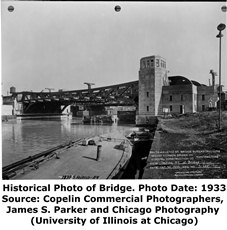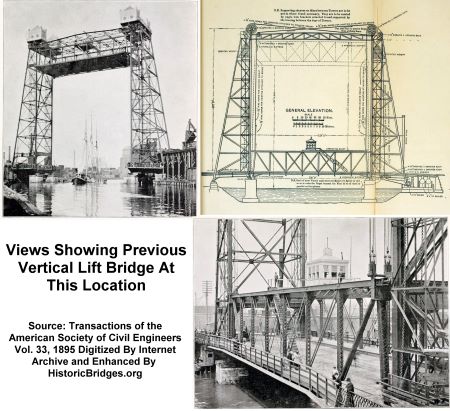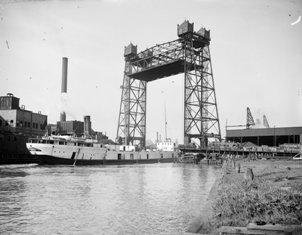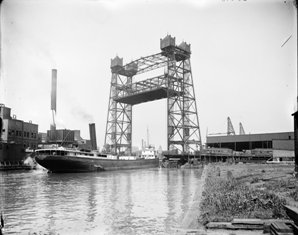We Recommend:
Bach Steel - Experts at historic truss bridge restoration.
BridgeHunter.com Phase 1 is released to the public! - Visit Now
Halsted Street South Branch Bridge
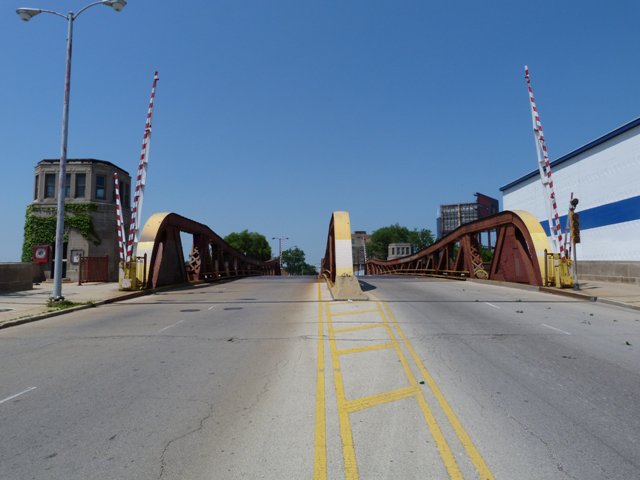
Primary Photographer(s): Nathan Holth
Bridge Documented: August 12, 2006
Chicago: Cook County, Illinois: United States
Metal Rivet-Connected Pratt Pony Truss, Movable: Double Leaf Bascule (Fixed Trunnion) and Approach Spans: Metal Stringer (Multi-Beam), Fixed
1934 By Builder/Contractor: Mount Vernon Bridge Company of Mount Vernon, Ohio and Engineer/Design: City of Chicago
1988
224.0 Feet (68.3 Meters)
316.0 Feet (96.3 Meters)
90 Feet (27.43 Meters)
1 Main Span(s) and 4 Approach Span(s)
16602426838

View Information About HSR Ratings
Bridge Documentation
View Archived National Bridge Inventory Report - Has Additional Details and Evaluation
View A Historical Article About The Previous Vertical Lift At This Location (Alternate High Quality Scan From Internet Archive)
About This Bridge
This bridge is one of only three pony truss bascule bridges in Chicago which is composed of three truss lines instead of two, allowing the bridge to have a much wider roadway.
The substructure for this bridge was built by the Fitzsimmons and Connell Company of Chicago, who appears to have built most of the substructures for Chicago's bascule bridges. For most Chicago bridges, the superstructure was built by local contractors, or at least small contractors who are not well-known nationally. This bridge is an exception, with its superstructure being built by the Mount Vernon Bridge Company of Mount Vernon, Ohio. The Mount Vernon Bridge Company was one of the bridge companies that existed back during the height of the pin connected truss era, and built bridges like Michigan's Martin Road Bridge. The company did not die out or get absorbed by the American Bridge Company during the turn of the 20th century, and instead continued on as a bridge builder and fabricator allowing it to make an appearance here in Chicago during the 1930s.
This bridge was constructed with the aid of a temporary bobtail swing bridge built to carry traffic while the bascule bridge was constructed following demolition of the previous lift span. This temporary bobtail swing bridge was later reused as a temporary bridge for Ashland Avenue.
Previous Bridges At This Location
The first documented bridge at this location was built in 1861 and was a wooden bridge built by Fox and Howard. In 1872, this bridge was rebuilt by the King Iron Bridge Company of Cleveland, Ohio as an iron bridge. This bridge was destroyed by a collision with the Steamer Tioga on June 21, 1892. The next bridge at this location (which preceded the existing bridge) was one of the first modern vertical lift bridges constructed in the United States. As such, it enjoyed a great deal of attention from engineers and appeared in many different engineering texts and periodicals. The bridge was designed by J. A. L. Waddell, who became a leading designer and advocate for vertical lift bridges. The portal bracing for this bridge originally included three plaques, a large plaque in the center and two smaller circular plaques at the knee braces. The knee braces also had ornate scrollwork. The bridge superstructure was constructed by the Pittsburgh Bridge Company of Pittsburgh, Pennsylvania.
|
Above: Historical Photos Showing Previous Vertical Lift Bridge. Source: Library of Congress |
![]()
Historic Bridges of Chicago and Cook County


Chicago and Cook County are home to one of the largest collections of historic bridges in the country, and no other city in the world has more movable bridges. HistoricBridges.org is proud to offer the most extensive coverage of historic Chicago bridges on the Internet.
General Chicago / Cook County Bridge Resources
Chicago's Bridges - By Nathan Holth, author of HistoricBridges.org, this book provides a discussion of the history of Chicago's movable bridges, and includes a virtual tour discussing all movable bridges remaining in Chicago today. Despite this broad coverage, the book is presented in a compact format that is easy to take with you and carry around for reference on a visit to Chicago. The book includes dozens of full color photos. Only $9.95 U.S! ($11.95 Canadian). Order on Amazon.
Chicago River Bridges - By Patrick T. McBriarty, this is a great companion to Holth's book shown above. This much larger book offers an extremely in-depth exploration of Chicago's movable highway bridges, including many crossings that have not existed for many years. Order Now Direct From The Publisher! or order on Amazon.
View Historic American Engineering Record (HAER) Overview of Chicago Bascule Bridges (HAER Data Pages, PDF)
Chicago Loop Bridges - Chicago Loop Bridges is another website on the Internet that is a great companion to the HistoricBridges.org coverage of the 18 movable bridges within the Chicago Loop. This website includes additional information such as connections to popular culture, overview discussions and essays about Chicago's movable bridges, additional videos, and current news and events relating to the bridges.
Additional Online Articles and Resources - This page is a large gathering of interesting articles and resources that HistoricBridges.org has uncovered during research, but which were not specific to a particular bridge listing.
![]()
Photo Galleries and Videos: Halsted Street South Branch Bridge
Bridge Photo-Documentation
Original / Full Size PhotosA collection of overview and detail photos. This gallery offers photos in the highest available resolution and file size in a touch-friendly popup viewer.
Alternatively, Browse Without Using Viewer
![]()
Bridge Photo-Documentation
Mobile Optimized PhotosA collection of overview and detail photos. This gallery features data-friendly, fast-loading photos in a touch-friendly popup viewer.
Alternatively, Browse Without Using Viewer
![]()
Maps and Links: Halsted Street South Branch Bridge
Coordinates (Latitude, Longitude):
Search For Additional Bridge Listings:
Bridgehunter.com: View listed bridges within 0.5 miles (0.8 kilometers) of this bridge.
Bridgehunter.com: View listed bridges within 10 miles (16 kilometers) of this bridge.
Additional Maps:
Google Streetview (If Available)
GeoHack (Additional Links and Coordinates)
Apple Maps (Via DuckDuckGo Search)
Apple Maps (Apple devices only)
Android: Open Location In Your Map or GPS App
Flickr Gallery (Find Nearby Photos)
Wikimedia Commons (Find Nearby Photos)
Directions Via Sygic For Android
Directions Via Sygic For iOS and Android Dolphin Browser
USGS National Map (United States Only)
Historical USGS Topo Maps (United States Only)
Historic Aerials (United States Only)
CalTopo Maps (United States Only)


